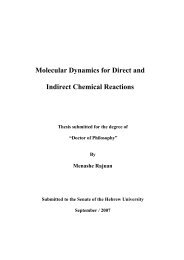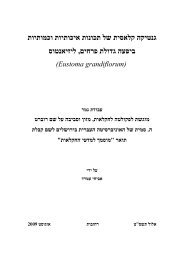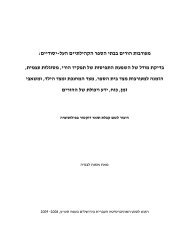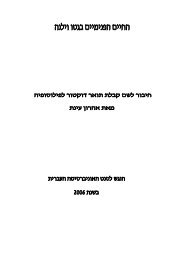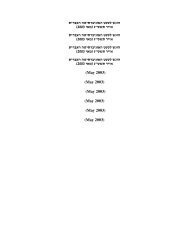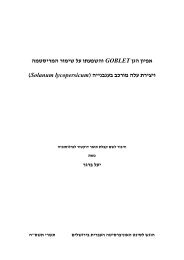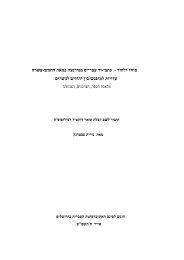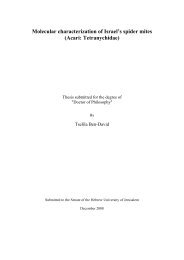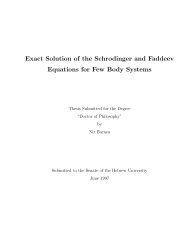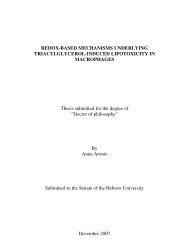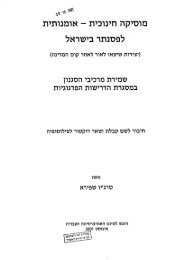Revealing the Mechanism of HSP104 Transcription Initiation in the ...
Revealing the Mechanism of HSP104 Transcription Initiation in the ...
Revealing the Mechanism of HSP104 Transcription Initiation in the ...
You also want an ePaper? Increase the reach of your titles
YUMPU automatically turns print PDFs into web optimized ePapers that Google loves.
21. Chandy, M., J. L. Gutierrez, P. Prochasson, and J. L. Workman. 2006.<br />
SWI/SNF displaces SAGA-acetylated nucleosomes. Eukaryot Cell 5:1738-47.<br />
22. Chi, Y., M. J. Huddleston, X. Zhang, R. A. Young, R. S. Annan, S. A. Carr,<br />
and R. J. Deshaies. 2001. Negative regulation <strong>of</strong> Gcn4 and Msn2 transcription<br />
factors by Srb10 cycl<strong>in</strong>-dependent k<strong>in</strong>ase. Genes Dev 15:1078-92.<br />
23. Choder, M. 2004. Rpb4 and Rpb7: subunits <strong>of</strong> RNA polymerase II and<br />
beyond. Trends Biochem Sci 29:674-81.<br />
24. Choder, M., and R. A. Young. 1993. A portion <strong>of</strong> RNA polymerase II<br />
molecules has a component essential for stress responses and stress survival.<br />
Mol Cell Biol 13:6984-91.<br />
25. Chu, B., F. Sonc<strong>in</strong>, B. D. Price, M. A. Stevenson, and S. K. Calderwood.<br />
1996. Sequential phosphorylation by mitogen-activated prote<strong>in</strong> k<strong>in</strong>ase and<br />
glycogen synthase k<strong>in</strong>ase 3 represses transcriptional activation by heat shock<br />
factor-1. J Biol Chem 271:30847-57.<br />
26. Chu, B., R. Zhong, F. Sonc<strong>in</strong>, M. A. Stevenson, and S. K. Calderwood. 1998.<br />
<strong>Transcription</strong>al activity <strong>of</strong> heat shock factor 1 at 37 degrees C is repressed<br />
through phosphorylation on two dist<strong>in</strong>ct ser<strong>in</strong>e residues by glycogen synthase<br />
k<strong>in</strong>ase 3 and prote<strong>in</strong> k<strong>in</strong>ases Calpha and Czeta. J Biol Chem 273:18640-6.<br />
27. Conl<strong>in</strong>, L. K., and H. C. Nelson. 2007. The natural osmolyte trehalose is a<br />
positive regulator <strong>of</strong> <strong>the</strong> heat-<strong>in</strong>duced activity <strong>of</strong> yeast heat shock transcription<br />
factor. Mol Cell Biol 27:1505-15.<br />
28. Cosma, M. P. 2002. Ordered recruitment: gene-specific mechanism <strong>of</strong><br />
transcription activation. Mol Cell 10:227-36.<br />
29. Cosma, M. P., T. Tanaka, and K. Nasmyth. 1999. Ordered recruitment <strong>of</strong><br />
transcription and chromat<strong>in</strong> remodel<strong>in</strong>g factors to a cell cycle- and<br />
developmentally regulated promoter. Cell 97:299-311.<br />
30. Dai, R., W. Frejtag, B. He, Y. Zhang, and N. F. Mivechi. 2000. c-Jun NH2-<br />
term<strong>in</strong>al k<strong>in</strong>ase target<strong>in</strong>g and phosphorylation <strong>of</strong> heat shock factor-1 suppress<br />
its transcriptional activity. J Biol Chem 275:18210-8.<br />
31. Deckert, J., and K. Struhl. 2001. Histone acetylation at promoters is<br />
differentially affected by specific activators and repressors. Mol Cell Biol<br />
21:2726-35.<br />
32. DeVit, M. J., and M. Johnston. 1999. The nuclear export<strong>in</strong> Msn5 is required<br />
for nuclear export <strong>of</strong> <strong>the</strong> Mig1 glucose repressor <strong>of</strong> Saccharomyces cerevisiae.<br />
Curr Biol 9:1231-41.<br />
33. Durchschlag, E., W. Reiter, G. Ammerer, and C. Schuller. 2004. Nuclear<br />
localization destabilizes <strong>the</strong> stress-regulated transcription factor Msn2. J Biol<br />
Chem 279:55425-32.<br />
34. Ekwall, K. 2005. Genome-wide analysis <strong>of</strong> HDAC function. Trends Genet<br />
21:608-15.<br />
35. Engelberg, D., E. Zandi, C. S. Parker, and M. Kar<strong>in</strong>. 1994. The yeast and<br />
mammalian Ras pathways control transcription <strong>of</strong> heat shock genes<br />
<strong>in</strong>dependently <strong>of</strong> heat shock transcription factor. Mol Cell Biol 14:4929-37.<br />
36. Erk<strong>in</strong>a, T. Y., and A. M. Erk<strong>in</strong>e. 2006. Displacement <strong>of</strong> histones at promoters<br />
<strong>of</strong> Saccharomyces cerevisiae heat shock genes is differentially associated with<br />
histone H3 acetylation. Mol Cell Biol 26:7587-600.<br />
37. Estruch, F. 2000. Stress-controlled transcription factors, stress-<strong>in</strong>duced genes<br />
and stress tolerance <strong>in</strong> budd<strong>in</strong>g yeast. FEMS Microbiol Rev 24:469-86.<br />
54



